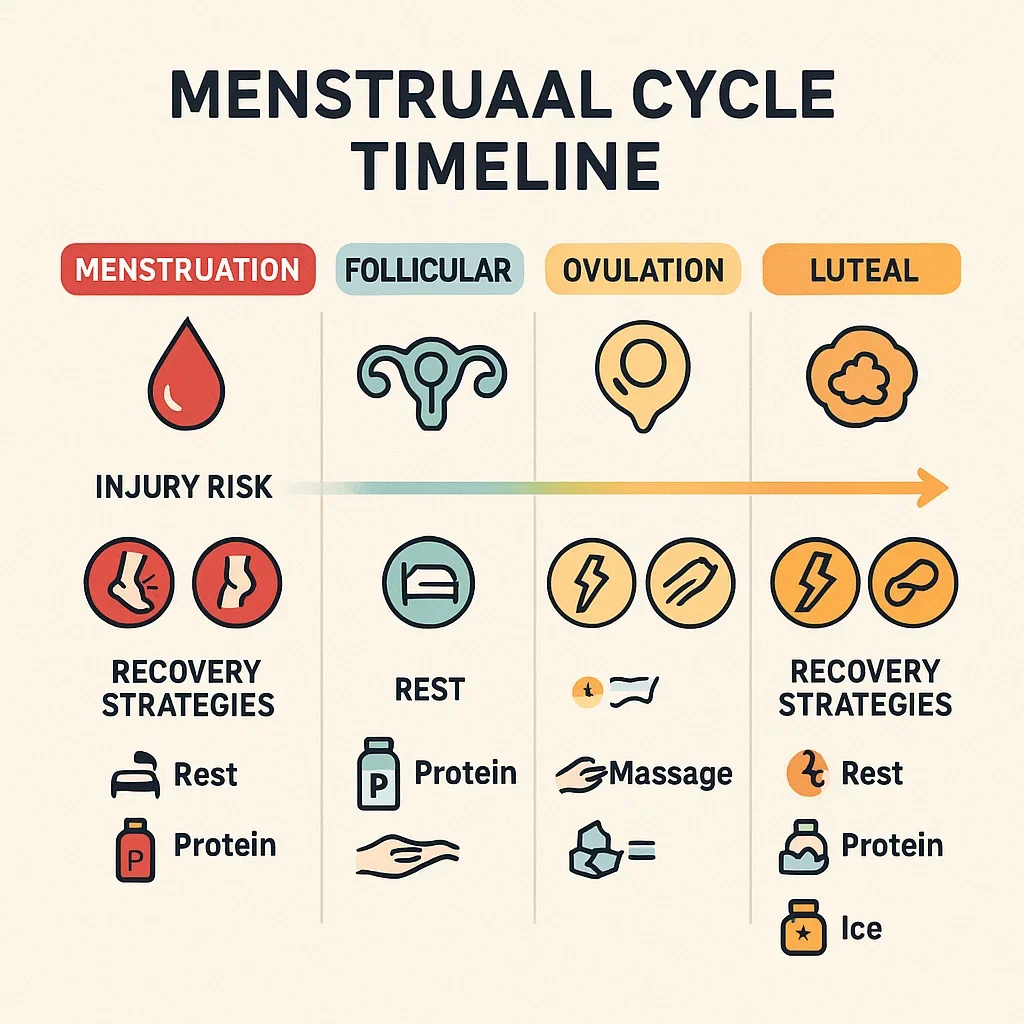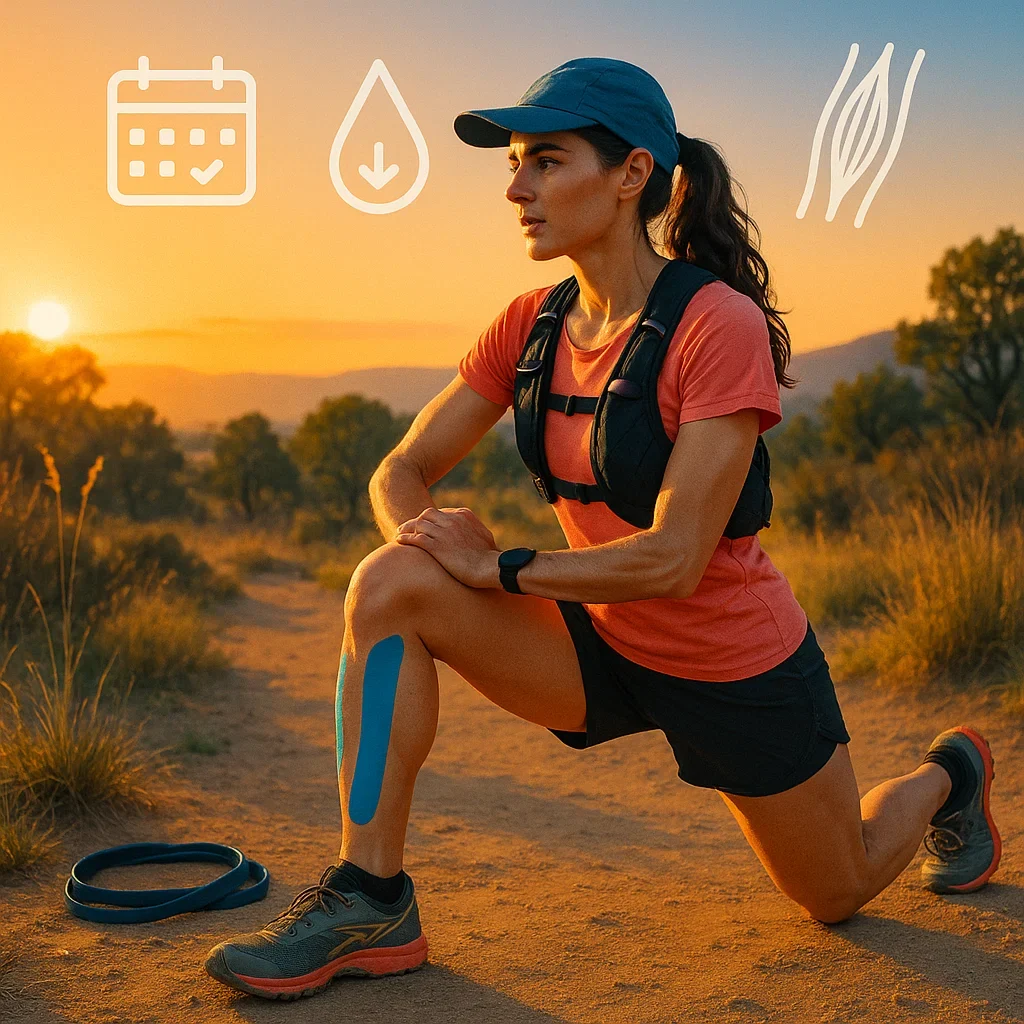Hormones, Tissue Health & Injury Risk: What Science Shows
- Estrogen: Supports collagen production, which helps keep tendons and ligaments strong. Estrogen peaks before ovulation, making connective tissues temporarily more elastic. For some, this raises the risk of ankle, knee, or hip injuries—especially on trails.
- Progesterone: In the luteal phase, progesterone rises and can increase muscle soreness, slow down muscle recovery, and boost inflammation. Hydration needs also go up.
- Cycle Impact: Research (Fort-Vanmeerhaeghe et al., 2023; Carmichael et al., 2021) confirms: injury risk is not the same all month. Most injuries (ankle sprain, muscle pull) spike just before and after ovulation. Fatigue and recovery times are often slower in the late luteal phase.
Lost Pace insight: Tracking your cycle alongside training notes reveals patterns—don’t rely on guesswork.
Injury Prevention and Recovery During the Menstrual Cycle for Ultra Runners
Endurance running is as much about staying healthy as it is about pushing limits. For female ultrarunners, the menstrual cycle brings unique challenges—and opportunities—for injury prevention and smarter recovery. By learning how hormone shifts influence your body’s tissues, fatigue, and risk levels, you can run stronger through every phase of the month.
This guide breaks down the latest science, phase-by-phase risks, and actionable strategies so you can avoid setbacks and recover like a pro—no matter where you are in your cycle.
Hormones, Tissue Health & Injury Risk: What Science Shows
- Estrogen: Supports collagen production, which helps keep tendons and ligaments strong. Estrogen peaks before ovulation, making connective tissues temporarily more elastic. For some, this raises the risk of ankle, knee, or hip injuries—especially on trails.
- Progesterone: In the luteal phase, progesterone rises and can increase muscle soreness, slow down muscle recovery, and boost inflammation. Hydration needs also go up.
- Cycle Impact: Research (Fort-Vanmeerhaeghe et al., 2023; Carmichael et al., 2021) confirms: injury risk is not the same all month. Most injuries (ankle sprain, muscle pull) spike just before and after ovulation. Fatigue and recovery times are often slower in the late luteal phase.
Lost Pace insight: Tracking your cycle alongside training notes reveals patterns—don’t rely on guesswork.
Where’s the Risk? Menstrual Phases & Injury Profile
- Menstruation (Days 1–5): Lower estrogen and progesterone may mean reduced joint laxity (less risk). However, fatigue, anemia, or dehydration can increase slips and falls. Warm up gently, hydrate, and respect your body’s signals.
- Follicular Phase (Days 6–13): Rising estrogen boosts muscle recovery and collagen. It’s a great time for harder efforts—risk of acute injury is lowest for most.
- Ovulation (Day 14): Peak estrogen increases ligament laxity (looseness) and coordination may temporarily dip. Sprains, ACL injuries, and muscle pulls are more likely, especially with sudden movement, descents, or technical trails.
- Luteal Phase (Days 15–28): Progesterone leads to higher core temperature, slower recovery, and sometimes “heavy legs.” Cumulative fatigue and poor sleep raise overuse injury risk (tendonitis, shin splints). Monitor soreness and prioritize rest.
Key takeaway: The danger zone for most runners: around ovulation and late luteal phase. But everyone’s “risky window” is unique—find yours by tracking.
Prevention Tactics: Phase by Phase
Menstruation
- Prioritize gentle warm-ups and mobility work.
- Replace lost iron with food or supplements (with doctor’s guidance).
- Stay hydrated—blood loss increases dehydration risk.
Follicular Phase
- Plan tough workouts and hill sessions here—body bounces back quickly.
- Add dynamic stretching and single-leg balance drills for extra resilience.
Ovulation
- Double down on injury prevention: longer warm-ups, proprioceptive drills, and post-run ice for sore joints.
- Use supportive footwear and consider taping vulnerable joints if you’re racing or on rough terrain.
- Listen for “niggles”—address small aches early.
Luteal Phase
- Reduce intensity or add rest if fatigue climbs.
- Foam roll, stretch, and emphasize protein and anti-inflammatory foods.
- Sleep is a superpower—get extra if you can.
Recovery: What Works in Each Phase?
- Post-run: Use protein-rich snacks and carbs within 30–60 minutes—especially after intense or long sessions in the follicular or ovulation phases.
- Active recovery: Low-impact cross-training, swimming, or yoga aids blood flow and recovery during heavy or sluggish luteal days.
- Inflammation control: Add omega-3s, turmeric, ginger, and dark berries. Ice sore joints after tough workouts in high-risk phases.
- Sleep: Women need more sleep when progesterone is high. Block blue light, nap after long runs, and use calming routines.
- Massage/self-care: Regular foam rolling, gentle stretching, and professional massage if available help counteract late-cycle tightness.
Lost Pace advice: If recovery is slow or new pains appear, reduce load and reassess your fueling and hydration. There’s no “hero badge” for running through injury.
Supplements & Foods that Support Injury Prevention
- Iron: Prevents anemia and supports oxygen transport. Essential after periods or heavy training blocks.
- Vitamin D & Calcium: Crucial for bone health—especially for high-mileage runners.
- Magnesium: Helps with muscle relaxation, cramp prevention, and quality sleep.
- Protein: Plant- or animal-based, repair tissues and minimize overuse injury risk.
- Hydration: Maintain electrolyte balance. Add extra sodium/potassium in the luteal and menstruation phases.
Note: Always consult a healthcare professional before starting new supplements—especially if you’ve had irregular periods or previous injuries.

Real Stories & Pro Tips from Female Ultrarunners
- “Tracking both my cycle and soreness meant I finally caught a stress reaction early—no more ignoring signals.”
- “I foam roll twice as long the week before my period, and I never skip core drills during ovulation.”
- “If cramps hit, I swap long runs for brisk walks or swimming—rest is recovery, not weakness.”
- Coach’s tip: “Encourage your athletes to note symptoms and soreness. Preventing one injury saves months of frustration.”
📚 Further Reading & Resources
Final Thoughts: Stronger, Smarter, and Unstoppable
Injury prevention isn’t just about protocols and perfect routines—it’s about knowing your body, respecting its rhythms, and building resilience across every phase of your cycle. The journey of a female ultrarunner is rarely linear; there will be days of boundless energy, and days when fatigue, soreness, or even doubt cloud your stride. But with every honest check-in, every smart adjustment, and every note you track, you are stacking the odds in your favor.
Hormones can’t—and shouldn’t—be ignored. Instead, let them be the ultimate “insider info” for your training. Listen to the gentle warnings of ovulation, protect your joints with prehab, and treat sleep as the ultimate supplement. Embrace the days when you need to slow down. Remember: pausing for recovery isn’t weakness—it’s wisdom in motion.
Science tells us that female athletes are resilient and adaptive—sometimes more so than we ever imagined. Your “risky” days are also your most insightful days. Every phase is an opportunity to learn, to strengthen, and to show yourself (and the world) what true endurance looks like.
- Track your symptoms and training, even if just in a notebook.
- Speak up—share changes with your coach or crew, and never hesitate to ask for support.
- Celebrate every small victory, especially those that come after struggle.
- Remember: no runner is alone in this. The more we share, the stronger our community grows.
Whether you’re facing a new PR, a tough trail, or a recovery week, do it with intention. Trust your body’s messages, honor your limits, and dare to dream big. Endurance isn’t just surviving every mile—it’s thriving through every cycle, becoming not just unbreakable, but truly unstoppable.
Keep moving forward—strong, smart, and proud.
—Lost Pace

About the Author
Lost Pace is an ultramarathon runner, shoe-tester and the founder of umit.net. Based year-round in Türkiye’s rugged Kaçkar Mountains, he has logged 10,000 + km of technical trail running and completed multiple 50 K–100 K ultras.
Blending mountain grit with data, Lost analyses power (CP 300 W), HRV and nutrition to craft evidence-backed training plans. He has co-written 260 + long-form guides on footwear science, recovery and endurance nutrition, and is a regular beta-tester of AI-driven coaching tools.
When he isn’t chasing PRs or testing midsoles, you’ll find him sharing peer-reviewed research in plain English to help runners train smarter, stay healthier and finish stronger.
Ultrarunner · Data geek · Vegan athlete

